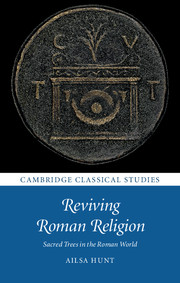Book contents
- Frontmatter
- Dedication
- Contents
- List of figures
- Acknowledgements
- 1 Rooting in: why give time to sacred trees?
- 2 A brief history of tree thinking: the enduring power of animism
- 3 How arboreal matter matters: rethinking sacrality through trees
- 4 Arboriculture and arboreal deaths: rethinking sacrality again
- 5 Confronting arboreal agency: reading the divine in arboreal behaviour
- 6 Imagining the gods: how trees flesh out the identity of the divine
- 7 Branching out: what sacred trees mean for Roman religion
- Appendix
- Bibliography
- Index
4 - Arboriculture and arboreal deaths: rethinking sacrality again
Published online by Cambridge University Press: 05 September 2016
- Frontmatter
- Dedication
- Contents
- List of figures
- Acknowledgements
- 1 Rooting in: why give time to sacred trees?
- 2 A brief history of tree thinking: the enduring power of animism
- 3 How arboreal matter matters: rethinking sacrality through trees
- 4 Arboriculture and arboreal deaths: rethinking sacrality again
- 5 Confronting arboreal agency: reading the divine in arboreal behaviour
- 6 Imagining the gods: how trees flesh out the identity of the divine
- 7 Branching out: what sacred trees mean for Roman religion
- Appendix
- Bibliography
- Index
Summary
Pliny's use of the verb colere to encapsulate how some Romans respond to the ficus Ruminalis (Nat. 15.77) gives us a glimpse of a world in which arboricultural interference with a tree might articulate religious conceptions of it. Yet, on one level, Pliny aims in this passage to distract attention from human interference with the ficus Ruminalis, encouraging us to experience for ourselves conceptions of it as a continuous organic unity, which work against the subtext of its dependence on human care and occasional replanting. His focus thus leaves many questions to be asked about the nature of arboricultural interference with sacred trees, and its implications for our understanding of the significance of a sacred tree's matter. Yet to date these questions have not been asked: scholars from Boetticher onwards, reliant on the idea that Roman sacrality means the transfer of an object to the gods' property, have understood any interference with a sacred tree to be blatant sacrilege, even if not all follow Boetticher quite so far as to deem it punishable by death or exile. Thus Thomas, in an influential article on tree violation in the Aeneid, articulates the standard view:
Every piece of relevant evidence from Greece and Rome, as from numerous other societies, conspires to demonstrate that the cutting of trees is a hazardous act, stigmatized by society and divinity alike.
Such ‘evidence’ can even be construed as a ‘law’, as when Hughes observes that ‘a basic law found everywhere forbade felling trees or cutting branches’. Indeed, if we add to this ‘law’ the common assumption that Roman thinkers considered trees sacred thanks to their perceived animation, then tree violation becomes an attack not just on divine property but on a divine spirit. Thus Thomas continues: ‘tree spirits are obviously hard to detect, and any tree is therefore potentially numinous, any tree felling potentially hazardous’.
Such assumptions are of course founded on juristic claims that being sacred meant belonging to a deity, reliance on which, as I have argued, stifles the complexity of what sacrality means in the Roman world. Yet it is not only a legalistic frame of mind among scholars of Roman religion which is to blame here.
- Type
- Chapter
- Information
- Reviving Roman ReligionSacred Trees in the Roman World, pp. 121 - 172Publisher: Cambridge University PressPrint publication year: 2016



